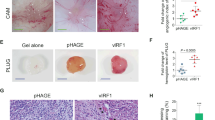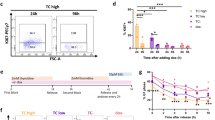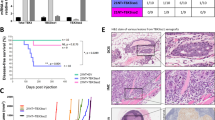Abstract
Vascular endothelial growth factor (VEGF), an important angiogenic factor, regulates cell proliferation, differentiation, and apoptosis through activation of its tyrosine-kinase receptors, such as Flt-1 and Flk-1/Kdr. Human malignant mesothelioma cells (HMC), which have wild-type p53, express VEGF and exhibit cell growth increased by VEGF. Here, we demonstrate that early transforming proteins of simian virus (SV) 40, large tumor antigen (Tag) and small tumor antigen (tag), which have been associated with mesotheliomas, enhanced HMC proliferation by inducing VEGF expression. SV40-Tag expression potently increased VEGF protein and mRNA levels in several HMC lines. This effect was suppressed by the protein synthesis inhibitor, cycloheximide. Inactivation of the VEGF signal transduction pathway by expression of soluble form of Flt-1 inhibited Flk-1/Kdr activation and HMC proliferation induced by SV40 early genes. Experiments with SV40 mutants revealed that SV40-Tag, but not -tag, is involved in the VEGF promoter activation. However, concomitant expression of SV40-tag enhanced Tag function. In addition, SV40-Tag expression sustained VEGF induction in colon carcinoma cell line (CCL)-233, which have wild-type p53, but not in CCL-238, which lack functional p53. These data indicate that VEGF regulation by SV40 transforming proteins can represent a key event in SV40 signaling relevant for tumor progression.
This is a preview of subscription content, access via your institution
Access options
Subscribe to this journal
Receive 50 print issues and online access
$259.00 per year
only $5.18 per issue
Buy this article
- Purchase on Springer Link
- Instant access to full article PDF
Prices may be subject to local taxes which are calculated during checkout




Similar content being viewed by others
References
Bocchetta M, Di Resta I, Powers A, Fresco R, Tosolini A, Testa JR . 2000 Proc. Natl. Acad. Sci. USA 97: 10214–10219
Browne K . 2001 Ann. Occup. Hyg. 45: 327–329
Carbone M, Pass HI, Rizzo P, Marinetti M, Di Muzio M, Mew DJ, Levine AS, Procopio A . 1994 Oncogene 9: 1781–1790
Carbone M, Rizzo P, Grimley PM, Procopio A, Mew DJ, Shridhar V, de Bartolomeis A, Esposito V, Giuliano MT, Steinberg SM, Levine AS, Giordano A, Pass HI . 1997 Nat. Med. 3: 908–912
Claudio PP, Stiegler P, Howard CM, Bellan C, Minimo C, Tosi GM, Rak J, Kovatich A, De Fazio P, Micheli P, Caputi M, Leoncini L, Kerbel R, Giordano GG, Giordano A . 2001 Cancer Res. 61: 462–468
De Luca A, Baldi A, Esposito V, Howard CM, Bagella L, Rizzo P, Caputi M, Pass HI, Giordano GG, Baldi F, Carbone M, Giordano A . 1997 Nat. Med. 3: 913–916
DeCaprio JA . 1999 Biologicals 27: 23–28
Finkenzeller GA, Sparacio A, Technau D, Siemeister G . 1997 Oncogene 15: 669–676
Gaetano C, Catalano A, Illi B, Felici A, Minucci S, Palumbo R, Facchiano F, Mangoni A, Mancarella S, Muhlhauser J, Capogrossi MC . 2001 Circ. Res. 88: E38–E47
Gonin S, Diaz-Latoud C, Richard MJ, Ursini MV, Imbo A, Manero F, Arrigo AP . 1999 Oncogene 18: 8011–8023
Hanahan D, Folkman J . 1996 Cell 86: 353–364
Kumar-Singh S, Weyler J, Martin MJ, Vermeulen PB, Van Marck E . 1999 J. Pathol. 189: 72–78
Orengo AM, Spoletini L, Procopio A, Favoni RE, De Cupis A, Ardizzoni A, Castagneto B, Ribotta M, Betta PG, Ferrini S, Mutti L . 1999 Eur. Respir. J. 13: 527–534
Pal S, Datta K, Mukhopadhyay D . 2001 Cancer Res. 61: 6952–6957
Paley EL . 1996 Carcinogenesis 17: 939–945
Procopio A, Strizzi L, Vianale G, Betta P, Puntoni R, Fontana V, Tassi G, Gareri F, Mutti L . 2000 Genes Chromosomes Cancer 29: 173–179
Romano M, Catalano A, Nutini M, D'Urbano E, Crescenzi C, Claria J, Davi G, Procopio A . 2001 FASEB J. 15: 2326–2336
Strizzi L, Catalano A, Vianale G, Orecchia S, Casalini A, Tassi G, Procopio A . 2001 J. Pathol. 193: 468–475
Takayama K, Ueno H, Nakanishi Y, Sakamoto T, Inoue K, Shimizu K, Oohashi H, Hara N . 2000 Cancer Res. 60: 2169–2177
Zhang L, Yu D, Hu M, Xiong S, Lang A, Ellis LM, Pollock RE . 2000 Cancer Res. 60: 3655–3661
Acknowledgements
This work was presented in part at the International Conference on Malignant Mesothelioma-Therapeutic Options and role of SV40: An Update, Chicago, Illinois (USA), April, 2001. It was supported by grants from the Associazione Italiana per la Ricerca sul Cancro (AIRC) and from the Italian Ministero dell' Università e della Ricerca Scientifica (ex 60%) to A Procopio. A Catalano was supported by a fellowship from FIRC. We thank Dr G Finkenzeller and Dr J Abraham for making the VEGF promoter construct, Dr MC Capogrossi for providing the adenovirus vectors, Dr G Vianale and Dr Strizzi for technical assistance and Dr M Bocchetta for providing the SV40 plasmids.
Author information
Authors and Affiliations
Corresponding author
Rights and permissions
About this article
Cite this article
Catalano, A., Romano, M., Martinotti, S. et al. Enhanced expression of vascular endothelial growth factor (VEGF) plays a critical role in the tumor progression potential induced by simian virus 40 large T antigen. Oncogene 21, 2896–2900 (2002). https://doi.org/10.1038/sj.onc.1205382
Received:
Revised:
Accepted:
Published:
Issue Date:
DOI: https://doi.org/10.1038/sj.onc.1205382
Keywords
This article is cited by
-
AXL regulates mesothelioma proliferation and invasiveness
Oncogene (2011)
-
Role of Toll-Like Receptor 3, RIG-I, and MDA5 in the Expression of Mesothelial IL-8 Induced by Viral RNA
Applied Biochemistry and Biotechnology (2010)
-
Simian virus 40 in humans
Infectious Agents and Cancer (2007)



